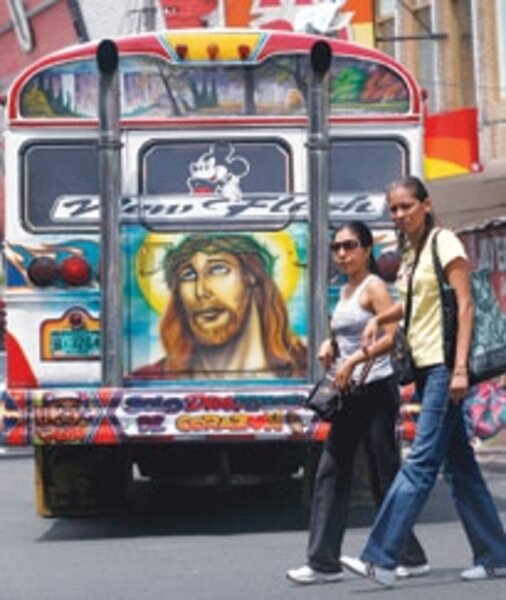Panama: Graffiti on wheels
• A local, slice-of-life story from a Monitor correspondent.
PANAMA CITY – Liriola Miranda, a college statistics professor, steps aboard Mr. Chiriqui, an old school bus blazing with splashes of red and green that give homage to the owner’s home province, Chiriqui, in Panama.
“The buses are an expression of identity,” she says of Panama City’s main transport system – a fleet of US hand-me-downs known affectionately in Panama as “red devils,” both for their hues and their hastiness as they fly down the capital’s roads, honking in search of passengers.
Sometimes the colorful expressions are patriotic, other times it’s something entirely different, Ms. Miranda explains, shaking her head as another “red devil” passes by, decorated with images of bikini-clad women in both back windows.
The “red devils,” painted down to the hubcaps, have turned Panama City’s streets into a whirl of bright reds and oranges and blues. Some are emblazoned with superheroes and saints, pictures of Colombian singer Shakira, or epic scenes of warriors fighting off lions.
Bus décor is a mixture of romanticism and manliness. Many are named after the owner’s girlfriend or wife – but they are also painted with macho slogans that shout “force,” “power,” and “thunder” or instructions like “If you don’t know the rules, I’ll teach them to you.”
But now the transport system, which is both ridiculed as anachronistic and celebrated (like the privately owned taxis called “tap-taps” that crowd Haiti’s capital, Port-au-Prince) as a form of public urban art, faces an uncertain fate.
The winner in Panama’s presidential election early in May, supermarket tycoon and right-leaning Ricardo Martinelli, made modernizing the public transportation system a main campaign pledge – calling for a Panama City subway to alleviate the traffic jams that have become chronic throughout the capital.
Carlos Diaz, a bus driver for 18 years, says he supports a new fleet of buses. “Let the new ones come,” says Mr. Diaz, behind the wheel of Mr. Chiriqui, his friend’s bus. “We’ll paint the new ones!” he says, smiling, before closing his doors and driving off.
For Miranda, it’s a mixed bag. “On one hand it is primitive. Panama is a city with money, and we deserve a good public transportation system,” she says, adding that her cellphone was stolen from her on her commute back from work recently.
Transportation consistently ranked as one of voters’ top concerns, and helped knock out the incumbent party. On the other hand, a new fleet will replace one of the last remaining idiosyncrasies of Panama City – not unlike the way a chain store drives out the local mom-and-pop shop.
“There is nowhere else in the world you can find these [buses],” says Miranda wistfully, but then perks up. “When they get rid of them, I’ll try to buy one as a souvenir,” she says. Or better yet, she brainstorms later, she can transport one to her home province and start a mini-tourist operation. “That way their memory will live on.”





